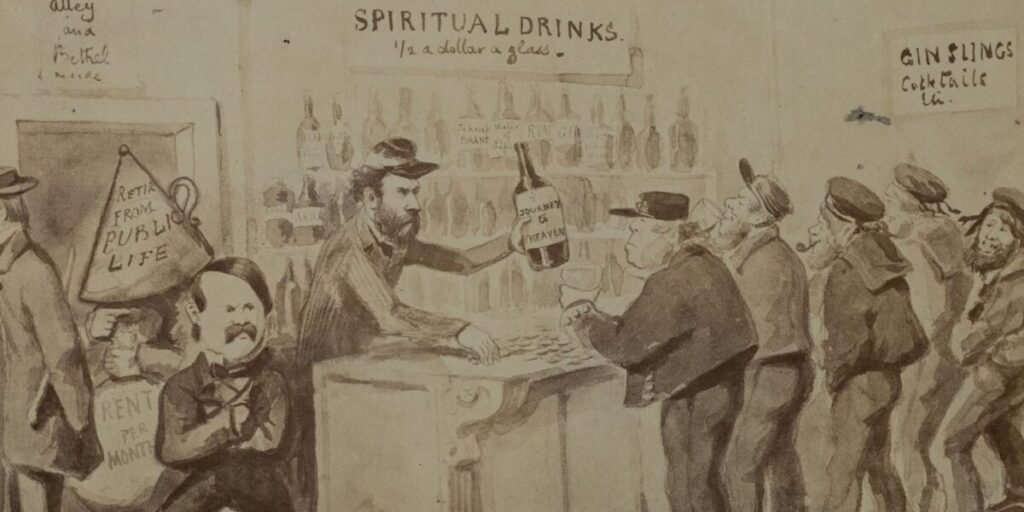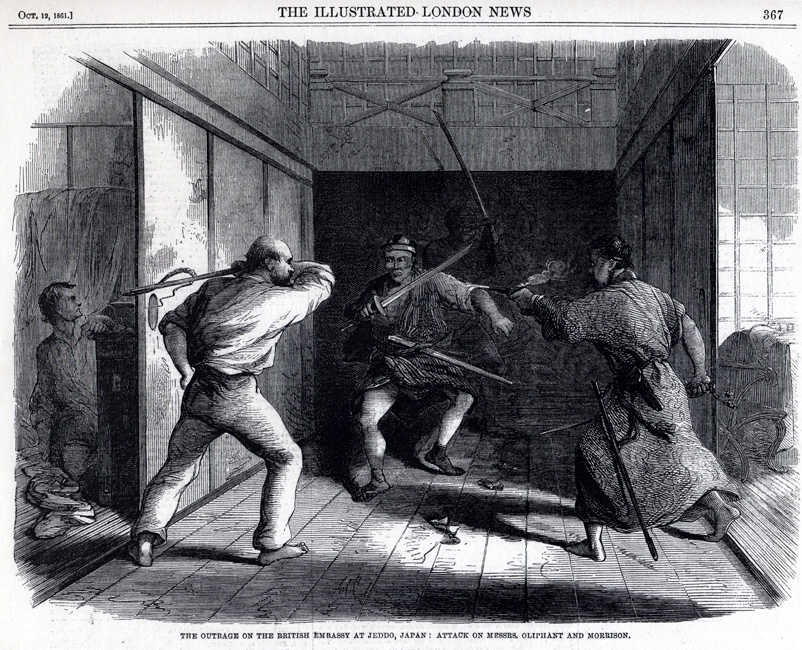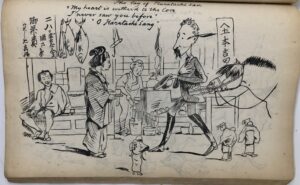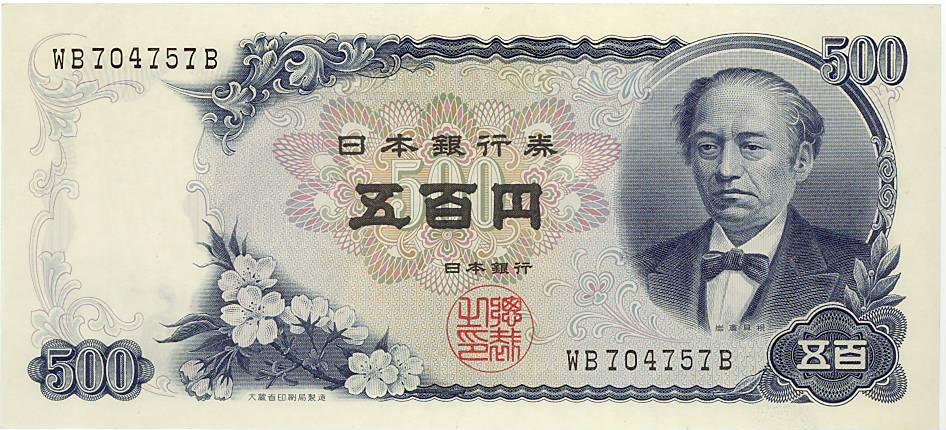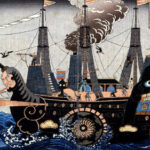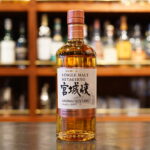1. Japan’s First Western-style Hotel
Four years after Perry concluded the Japan-US Treaty of Peace and Amity with the Shogunate and opened the country to the outside world.
In June 1858, U.S. Consul General Townsend Harris signed the United States-Japan Treaty of Amity and Commerce in order to start full-scale trade with Japan.
At the same time, the United States signed treaties of amity and commerce with the Netherlands, Russia, the United Kingdom, and France, which resulted in the arrival of merchants from these countries and a flood of foreign cultures.
The Treaty of Amity and Commerce included the provision of a settlement where foreigners could live and do business.
The resulting influx of foreign information and culture, and the Shogunate’s response to it, led to a variety of dissatisfaction and concern about the future of Japan, and the Sakuradamon Incident of 1860(the first year of Manen), the Tenchugumi Incident of 1863(Bunkyu 3), the Ikuno Incident, the Anglo-Satsuma War, all of which divided Japan into two factions: the overthrowing shogunate faction led by Sakamoto Ryoma and others, and the supporters of the Emperor’s exclusion of the barbarians.
Even in the midst of such upheaval, foreign merchants were strong enough to demonstrate their business acumen in the various ports that were opened to them.
1-1 Captain Huffnagel’s Hotel

“Gokaiko Yokohama Dai Ezu Ni-hen Gaikokujin Jyutakuzu” by Utagawa sadahide
In 1859, the Yokohama Foreign Settlement had just been established and there were no accommodations yet.
In November 1859(Ansei 6), Captain Huffnagel of the Dutch-flagged sailing ship Nassau sold the Nassau in Yokohama, and in February 1860(the first year of Manen), he opened the “Yokohama Hotel” in the Yokohama Foreign Settlement.
Incidentally, the Nassau was later used as a storage ship.
The name “Nassow Hoisu” is written on the illustration drawn by Sadahide Utagawa, which is thought to have been derived from the Nassau.
There are various theories, but it is believed that this Yokohama Hotel was the first hotel in Japan, and it also had a bar inside the hotel, which is said to be the first of its kind in Japan.
Unfortunately, the hotel was destroyed by a huge fire in 1866 (Keio 2) in the Yokohama Settlement, and most of its materials have been lost, but there are many famous people who stayed at the hotel, including Siebold, a German physician and naturalist, and Wilhelm Heine, a painter who accompanied Perry on his travels. There are accounts that Siebold, a German physician and naturalist, and Wilhelm Heine, a painter who accompanied Perry, among others, stayed at the hotel.
In 1860, Count Eulenburg of the Kingdom of Prussia, whose capital was Berlin, landed in Japan to conclude the Prussia-Japan Treaty of Amity and Commerce, and the merchant Gustav Spiess, who accompanied him, wrote in his book “Spiess’s Expedition to Prussia in Japan” about the situation.
Although the building itself was a Japanese-style house, it was equipped with an airy dining room, billiard room, bar, etc., and the rooms were furnished with a table and two chairs. However, he also states that the beds were “a kind of bunk” and that there were no windows or stoves. The Yokohama Hotel in 1860 was popular as the only place in the foreign settlement in Yokohama where one could play chess.
In addition, a passage in Siebold’s travelogue mentions that he stayed at the Yokohama Hotel in Hufnagel and that the rate was $2 per night, or $50 for one month of consecutive stays.
Unfortunately, there is actually no clear description of what kind of whisky was available at the bar in this first Japanese hotel, “Yokohama Hotel.”
However, we have found a few documents related to whisky from trade records and documents left behind by foreigners who came to Japan, so it is difficult to determine the brand name, but we would like to introduce them here.
*Cooperation Yokohama Central Library, Yokohama Port Opening Museum, Kanagawa Prefectural Museum of History, Kawasaki City Museum (in no particular order)
1-2 Caricature “Japan Punch” by Charles Wairgman
As a correspondent and illustrator for the British weekly newspaper “Illustrated London News,” Charles Wairgman arrived in Nagasaki, Japan, on April 25, 1861, and then traveled overland to Edo, Japan, accompanied by a delegation from the British Minister to Japan, Allcock.
On May 28 of the same year, he was attacked at Tozenji Temple, which had served as the British legation, by Mito clan ronin, barbarian expulsionists who claimed that “Shinshu Japan had been defiled by foreign men.”
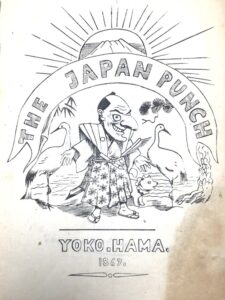
Japan Punch Cover
At this time, Wairgman recorded the entire incident while sheltering under the rim and made this into articles and sketches.
In 1862, he launched “Japan Punch,” a magazine for foreign residents in Japan.
This magazine was modeled after the British satirical cartoon magazine “Punch,” which is also the origin of the word punch picture.
It depicted the lives of people living in the Yokohama Settlement, criticism of the Japanese government, and attacks on English-language newspapers in the same trade, using satirical cartoons and text.
The second issue was published in 1865 and continued to be published monthly for the next 22 years.
Japan Punch published humorous criticism and satire on the Ansei Treaties, Japan’s international relations, Japanese domestic politics, media coverage, and prominent figures in the diplomatic and economic world.
It also touched on the diversity of the foreign settlement in Yokohama, where Wairgman noted in “Punch” that “people of 337 nationalities” ran businesses.
Wairgman’s mastery of English, German, and French, and his command of a variety of languages, led him to utilize comics to try to engage and communicate with a large audience by writing in multiple languages, including English, French, Italian, Latin, Japanese, Chinese, and Dutch. The first Japan Punch was established in 1862.
Japan Punch ceased publication between 1862 and 1865.
It is said that this was due to the Shogunate’s notification that it would be punished if it published content that slandered others.
The fact that even the Shogunate was aware of Japan Punch’s activities suggests that ordinary Japanese people may have been reading the magazine at that time.

The Bourbon dynasty, from which the word “Bourbon” is derived, is superimposed on the Tokugawa family. A material that seems to be a scathing criticism of the former Bourbon dynasty and the collapse of the shogunate by using it as a pun material.
As noted above, alcohol is frequently mentioned in the content published in Japan Punch.
It is possible that some ordinary people at the time had at least heard of whisky.
1-3 James B. Macaulay, the first bartender in Japan

Image source Bartender CATMAN’s blog The Herald announcing the opening of the Royal British Hotel
As mentioned above, there was a bar in the Yokohama Hotel, which was owned by Huffnagel.
Standing at this bar counter was a Jamaican of British nationality by the name of “James B. Macauley.”
Nicknamed “The Baron,” he was a black bartender.
At the time, the bar was more like a tavern in a western movie than a bar, and patrons often played billiards or used the bar as a place to vent their frustrations and complaints about the treatment of foreigners in Japan. There were even times when pistols were fired inside the bar.
The large clock above the door of the bar had many bullet holes in it, and it was used as a target for test firing of pistols.
Macaulay, a strong man in a bar full of thugs, must have been a bodyguard.
After leaving Huffnagel, Macaulay opened the “Royal British Hotel” on October 25, 1862, at 85th Street.
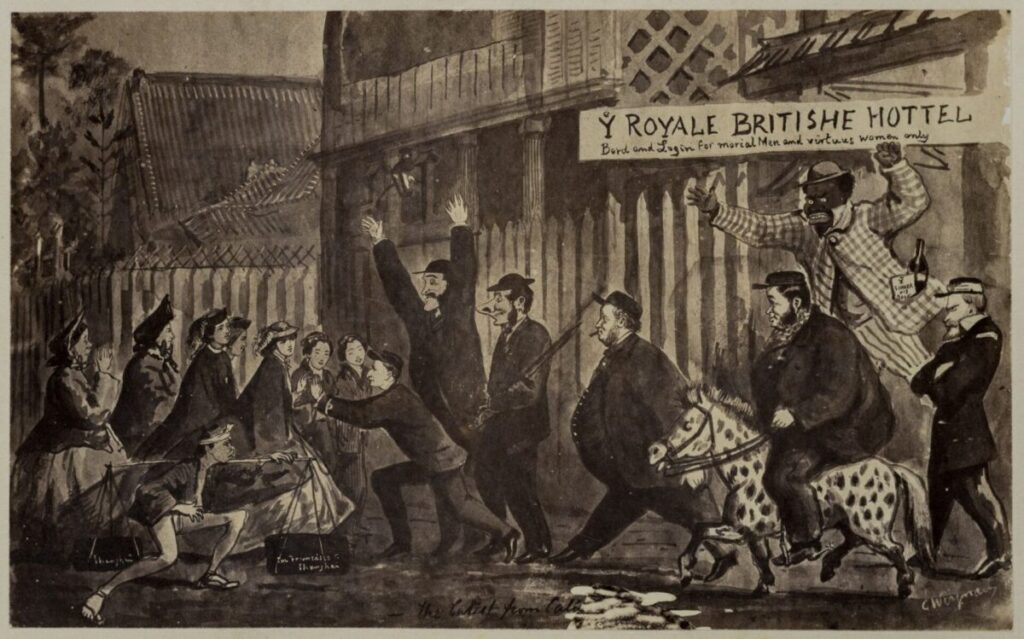
“Photograph Album of Works by Charles Wairgman, photographed by Felix Beato”, Courtesy of Kawasaki City Museum
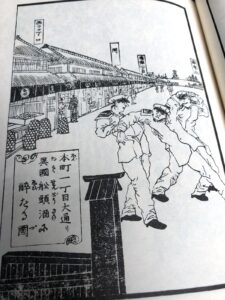
Image source: “Yokohama Kaiko Kenmon Shi” from bartender CATMAN’s blog, depicting an inebriated sailor
It depicts a man who appears to be Macaulay yelling at a customer.
This caricature suggests that the Yokohama Settlement at that time was a place of considerable disorder.
Yokohama citizens did not have a good image of foreigners at this time, and there are records of complaints of sailors left homeless after their ships departed before they knew they had arrived, and of drunkenness on the streets causing trouble in the neighborhood.
Around 1862, commercial establishments such as various hotels and town taverns opened one after another, and with them, many Western liquors were imported for the foreign public.
Whisky, Old Bourbon, Irish, and Scotch, known as “Wheat Sheaf,” were imported, as an 1864 advertisement in the Japan Herald confirms.
Other imports included Geneva, several types of gin including “Old Tom,” “Chartreuse,” maraschino, curacao, and mint liqueur.

Image source Whisky Magazine 1964 Japan Herald ad

“Photograph Album of Works by Charles Wairgman, photographed by Felix Beato”, Courtesy of Kawasaki City Museum
1-4 Eiichibankan
“Jardine Matheson & Co.” which was mentioned in Chapter 2, “Perry’s Arrival in Japan,” was one of the first to open a branch after the port opened, and established a Yokohama branch in Yamashita-cho 1, Naka-ku, Yokohama City, Kanagawa Prefecture (present-day Yamashita-cho Reservation No. 1), which was known by the local people as “Eiichibankan,” after its street address.
This Yokohama branch was the first foreign company to enter Japan.
It probably also handled its own scotch, “Old Vatted Glenlivet.”
The Yokohama branch was also destroyed by a piggery fire, but today, a facility called the “Silk Center” stands at 1 Naka-ku, Yokohama City, for the purpose of promoting the raw silk and silk industry, trade, and tourism at the port of Yokohama, and there is a monument at the entrance that is said to have once housed the Eiichibankan.
As an aside, “William Keswick (the son of the elder sister of William Jardine, the founder of the Jardine Matheson & Co. )” who established the “Yokohama branch of the Jardine Matheson & Co.” later supported five people called the “Choshu Five,” including “Hirobumi Ito,” in their study in England.
1-5 Mysterious Cat’s Mark Whisky
-300x142.jpg)
Source: Whisky Magazine, April 1897, market price list published by Itsumi Sanyodo
The oldest record of a whisky product name that clearly appears in existing documents is from 1871, four years after the Taiseihokan was passed and the name of the country was changed to Meiji.
It is said that the Carnot Trading Company in Yokohama imported “Irish Whisky Nekojirushi” (Irish Whisky Cat Seal).
The price list published by Itsumi Sanyodo (later Sanyodo), shown at right, dates from 1897, and includes “Irish Whisky Nekojirushi” and “Shikajirushi Whisky Romal blend.”
The deer symbol is often used on Scotch whisky labels, but unfortunately, there is no data to determine that the Deer Seal Whisky Romal Blend is Scotch.
So what kind of product was the Irish whisky Nekojirushi?
Mamoru Tsuchiya of the Whisky Culture Research Institute and Kazuo Ishikura of Whisky Magazine have suggested that it may have been “Burke’s Fine old Irish Whiskey.”
This opinion led Asako Mizuno, a patent translator, to write a very interesting blog, making full use of the world’s patent databases .
In the process of unraveling the patent perspective, Ms. Mizuno discovered an overseas website called “Meiji-Portraits,” which covers trading companies that were active in Japan during the Meiji Era.

Image source Patent Translation A to Z
In that site, you can search for whisky and come up with
The notation “J. Curnow & Co.”
Probably “Curnow & Co.”
Surprisingly, “Curnow & Co.” also handled Glenlivet, which “Jardine Matheson & Co.”
In addition, there is a notation “Robert Brown’s
‘Four Crown’ Whisky.”
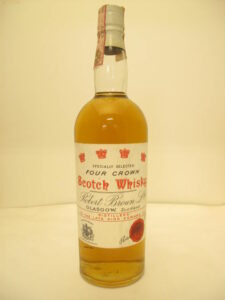
Source whisky paradise Robert Brown’s Scotch Whisky.
Robert Brown, a native of Glasgow, established his business in 1865, blending and exporting whisky, and his whisky was even drunk by Queen Victoria at that time, according to “Old Glasgow Pubs,” an overseas website featuring pubs in Glasgow.
However, there is no indication in the “Meiji-Portraits” data that the Curnow & Co. ever handled Burke’s whisky.
The data is from a 1915 book titled “History of Japanese and Western Canned Spirits,” published by the Nippon Wayosyu Kanzume Newspaper Company, which lists the year, item, importer name, and container shape.
On page 294, it states, “The following is a list of imported Western liquor dealers and their products in the first year of the Meiji Era,” and the basis for this is “Nekojirushi Whisky, Curnow & Co., shoulder-length round bottles” in the entry for the 4th year of Meiji Era(1871).
1-6 Whisky presented to the Emperor
When foreign cultures began to flow in after the opening of the ports and whisky began to be seen more and more, did the rulers of the time drink whisky? Incidentally, there is no record of the emperor drinking the whisky that Perry is said to have presented to him.
What remains as an official document is the Scotch whisky that “a certain delegation” is said to have brought back and presented to the Emperor.
As many of you may know, we would like to approach the first Japanese person to bring whisky to Japan.
2. The Ten Great Masters of the Meiji Restoration Iwakura Tomomi
Born in Kyoto as the second son of Gon chunagon, Horikawa Yasuchika. His mother was Yoshiko, daughter of Kajuji Tsunehaya.
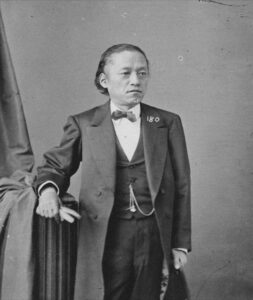
Image source Wikipedia
Although her childhood name was Kanemaru, she was called “Iwakichi” by the children of court nobles because her appearance, speech, and behavior were uncharacteristic of a court noble.
She later became a student of Nobuharu Fusehara, a Confucian scholar in the service of the Imperial Court.
Fusehara saw Iwakura as “a man of great ability” and recommended his adoption into the Iwakura family.
On August 8, 1838(Tenpo 9), at the age of 13, he was adopted into the Iwakura family and given the name Tomomi by Fusehara.
The following year, he served at the Imperial Court and received 100 bales of rice.
Although the Iwakura family had the rank of Urin family, it was a young family with a short history, and the ranks and offices to which the head of the Iwakura family was appointed were not high.
The Iwakura family was not wealthy, as there was no family business handed down from generation to generation.
2-1 Glory and fall
In January 1853 (Kaei 6), he was introduced to the art of poetry by the Kanpaku Takatsukasa Masamichi (a group that studied waka poetry such as the Manyoshu). This was a major turning point for Iwakura, who was only a low-ranking courtier, to speak to the leaders of the Imperial Court, and at the age of 29 he was promoted to the position of attendant to Emperor Komei.
Iwakura, who had demonstrated outstanding political power at the Imperial Court, was a member of the Kobu Gattai faction and brought about the marriage of Kazunomiya and Tokugawa Iemochi, based on the principle of bringing the Imperial Court and the Shogunate, which had been on bad terms since the Ansei no Taigoku.
However, this action aroused suspicion from some that he was a member of the Sabaku faction. Doubts about his actions led some to suspect that he might be a member of the supporters of the shogunate, and these doubts eventually led to his being ordered to leave his estate, resign from the government, or be ordained as a monk.
In the end, he was ordered to leave his estate, resign from the government, and leave the Imperial Court.
He was ordered to leave his estate, but the sonnojoi faction still felt that the punishment was too lenient, and he even received a threatening letter demanding his removal from Kyoto.
Fearing for his safety, Iwakura could no longer continue to stay at his estate and took the form of a monk and went into hiding at Reigenji Temple in Nishigamo.
He moved to Saiho-ji Temple in Rakusai, where his foster father’s nephew was the chief priest, but the lord Konoe Tadahiro issued a decree banning him, saying that “he should not live in Rakuchu.”
Iwakura’s eldest son, Iwakura Tomotsuna, offered a helping hand to the beleaguered Tomomi, who had nowhere to go and no place to live.
He prepared a house in the village of Iwakura in Rakuhoku Kyoto (coincidentally, the name of the village is the same as that of Iwakura), where he lived in exile for five years.
During his five years in exile, the Kinmon Incident of 1864 swept away the expulsion of the barbarians from Kyoto, but this did not pardon Iwakura, and he was forced to continue living in Iwakura Village.
However, there was someone who visited Iwakura.
2-2 A Political Opponent Who Returned to Power
The people who came to see him were Toshimichi Okubo and Shintaro Nakaoka.
As he met with them, he began to send political opinions to the Imperial Court and his comrades in the Satsuma Clan.
In his diary, Tomomi Iwakura wrote about this meeting and also mentioned the visit of Ryoma Sakamoto.
By this time, Iwakura Tomomi had changed his views from the Kobu Gattai faction to the anti-Shogunate faction.
In 1867, Emperor Komei died, and with the accession of Emperor Meiji to the throne, his long period of residence at his estate was finally lifted.
Immediately after his accession to the imperial court, Iwakura went to the court to carry out the great decree of restoration of the monarchy in 1868 and proclaimed the establishment of a new government, thereby giving birth to the Meiji government.
After that, the government structure was reconstructed, and the government shifted to a government with the separation of powers based on the American political system. After the Ueno War, one of the biggest civil wars in Japan, Edo was settled and renamed Tokyo.
In July 1871 (Meiji 4 ), the government proclaimed the abolition of feudal domains.
On this day, all feudal lords who had lost their domains were summoned to Tokyo to fulfill their duties as nobles.
Japan was to start as a unified nation under a single head of state and a single head of state.
On the same day, Tomomi Iwakura assumed the position of Lord of Foreign Affairs (today’s Ministry of Foreign Affairs).
Iwakura had the difficult task of “revising” the “United States-Japan Treaty of Amity and Commerce,” commonly known as the Treaty of Inequality that had been concluded with the United States.
Japan, which was not yet in compliance with what is now known as international law “Elements of International Law,” embarked on a plan to travel around the world, broaden its knowledge, and civilize Japan before negotiating a revision of the unequal treaties in order to avoid being forced by the U.S. to extend the unequal treaties.
2-3 Whisky of the man who died at the age of 152
Iwakura himself was the first Ambassador Extraordinary and Plenipotentiary, accompanied by Takayoshi Kido, Toshimichi Okubo, Daisuke Kobu, Hirobumi Ito, and others as deputy ambassadors.
After forming the Iwakura Mission, they left the port of Yokohama in November 1871 (Meiji 4) and traveled around Europe and the United States for a year and ten months, meeting heads of state and handing them state letters, but they did not seem to have achieved much.
During this trip, Iwakura brought back a bottle of blended scotch called “Old Parr“ and presented it to the Emperor.
The bottle of Old Par was shaped so that it would not topple over even if it was tilted, and it was considered auspicious because it was “right side up.”
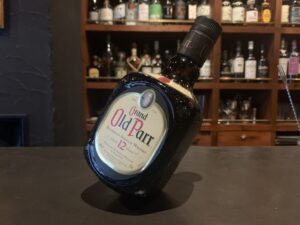 Therefore, there are many political figures who love to drink Old Par as well, such as Shigeru Yoshida and Kakuei Tanaka.
Therefore, there are many political figures who love to drink Old Par as well, such as Shigeru Yoshida and Kakuei Tanaka.
Incidentally, the label of this Old Parr is based on a drawing by Rubens, a master of the Baroque era, and the old man’s name was “Thomas Parr.”
A real person who lived to be 152 years old.
Born in England in 1483.
He married for the first time at the age of 80, had a son and a daughter, but died at an early age, had an affair with the most beautiful woman in the village at the age of 105, had a child, and at the age of 112, his wife Jane died, but he remarried at the age of 122, and after hearing legend after legend, Rubens and Van Dyck also included him in their paintings.
His fame spread to the King of England, who asked for an audience, and he went to London and settled there, but soon passed away.
The cause of his death was overeating.
It seems that the glittering life in London hastened his death.
He still rests in Westminster Abbey, where the British kings, Isaac Newton, and others are buried.
2-4 Truth of the Internet
The “theory that Tomomi Iwakura brought back the Old Parr” has been circulating on the Internet as a common theory, but when we contacted the management office of the “Former Residence of Tomomi Iwakura,” which is familiar with Tomomi Iwakura, and found that the following is a list of the Old Parr that were brought back by Tomomi Iwakura.
We are aware of the story that Tomomi Iwakura brought back Old Parr and presented it to the Emperor Meiji, but we have not yet seen any evidence of this story, only information on the Internet. If you could give me a few minutes of your time, I would like to look into it as much as I can and get back to you.
We apologize for the inconvenience, but could you please give us some time?
Thank you very much for your time.
(Original text)
The answer was shocking.
We will add new details as soon as they become available.
*February 25, 2011 addition
Thank you very much for your kind attention.
We would like to inform you of the results of our confirmation of the relationship between Tomomi Iwakura and Old Parr, which you previously inquired about, although it took us some time.
We have checked the official record of Iwakura’s overseas trip, “a true account of the ambassador extraordinary and plenipotentiary’s journey of observation through the United States of America and Europe,” and found no mention of a whisky factory, although there is a record of a trip to the Scottish Highlands.
We also checked the “Ambassador’s Report,” which is the original source of the above document, and found a record of a visit to the Highlands, but no mention of a visit to a whiskey factory or other facilities.
Finally, we also checked the memoirs of Kunitake Kume, the author of the official record of the mission, and found no mention of the Old Parr in his memoirs.
As mentioned above, I checked the documents that might have appeared in the book, but I could not find any relevant descriptions.
Unfortunately, we were not able to find anything that meets your expectations this time, but we will continue to check the records from time to time.
Thank you for your continued support.
We apologize for the delay, but we would like to respond to your inquiry.
February 25, Chief Curator, Tomomi Iwakura Former Residence Management Office
I came to the conclusion that
We also contacted Diageo, the company that handles Old Parr.
Thank you for your inquiry to the MHD website.
Although there is still a story about the founder, the Greenlees brothers, bringing back the whisky they made, Diageo’s recorded release of Old Par was in 1909 (after Tomomi Iwakura’s death).
Therefore, we do not have any information on Iwakura Tomomi, and therefore, we do not communicate with him as a brand.Thank you in advance for your cooperation.
They told me that they are working on it.
The deeper I dig into the story, the more romantic it becomes.
After returning from a trip to Europe and the United States, Iwakura worked hard to protect Japan from foreign countries and died at the age of 59 on July 20, 1883 (Meiji 16), before the enactment of the Constitution of the Empire of Japan, which is the basis of the current Constitution.
Iwakura Tomomi, who had cancer of the pharynx, was the first person in Japan to be diagnosed with cancer, the first person in Japan to be given a state funeral, and the portrait on the 500-yen bill that was issued until 1985(showa 60).
It was also the portrait on the 500-yen bill that was produced until 1985.
~History of Japanese Whisky~
https://en.jpwhisky.net/history-2/whiskeyhistory1-2/
https://en.jpwhisky.net/history-2/history-whiskeyhistory2-2/
https://en.jpwhisky.net/history-2/history-whiskeyhistory3-2/
[box type=”note” align=”” class=”” width=””]
Chapter 4: Shinjiro Torii
Recently released[/box]
[box type=”note” align=”” class=”” width=””]
Chapter 5: Kiichiro Iwai
Recently released[/box]
[box type=”note” align=”” class=”” width=””]
Chapter 6: Masataka Takesuru
Recently published[/box]
[box type=”note” align=”” class=”” width=””]
Chapter 7: Before and after the battle
Recently published[/box]
[box type=”note” align=”” class=”” width=””]
Chapter 8: High growth period – Now
Recently published[/box]

